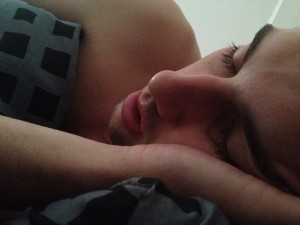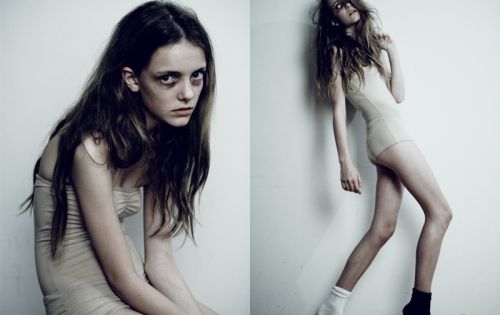Sasha submitted a new blog post:
The Real ME: A Stock Photography Resource for the Media
Sasha announces a new resource of appropriate photos for ME/CFS media stories ...
We’ve all seen them in the news stories about ME/CFS: the guy in a suit at the office, yawning; the beautiful woman sitting at her desk with her immaculate make-up and elegantly coiffed hair, hand to her head and looking slightly pained.
But do pictures that illustrate ME/CFS by showing office workers suggest that this level of function is as bad as this condition gets?
For years, patients have been up in arms about this issue, and #MEAction recently started a great campaign for patients to contribute their own photos to the cause.
However, coming up with photos isn’t easy, and it will take a long time to build a suitable pool.
But why is it so hard?
It all has to do with how the media tells stories. Let’s take a look at two health articles in the same UK national newspaper — the Daily Mail.
The first story is about a particular little boy, and all the photos of him have a real-world look which is due to their imperfect, cluttered settings and the not-great lighting and his natural expressions and poses.
The second is a story about a health issue affecting women in general, not a specific person. Note the beautiful women, flawless make-up, elegant clothes, lovely hair — sound familiar? — but also the production values: perfect composition, professional lighting, the total lack of background clutter.
It all says, ‘this is a photographic model in a staged setting, not a person who genuinely has this health problem.’ And it’s an absolutely standard approach by the media to general articles about health issues.
Unless an ME/CFS article is about a specific patient, that’s the kind of photo we’re going to need to provide: a professionally photographed, high-production-values shot that shows someone who is clearly a model, but who is giving an accurate portrayal of the disease.
That’s the only kind of photo that a media outlet is likely to use: and they’ll want it to be in stock photography libraries because they already subscribe to them and are confident about the licensing arrangements.
Our problem is that when a picture-desk editor types ‘chronic fatigue syndrome’ or ‘fatigue’ into a stock-photo searchbox, it produces the yawning office guys and the headache women.
So until someone produces some professional custom-shots or sorts those stock-library tags out, Phoenix Rising has produced a resource of links to suitable photographs from major picture agencies iStock and Shutterstock.
I hope that our charities who deal with the media will make journalists aware of it, and that they’ll alert their picture desks.
The days of yawning guy are surely numbered.
But meanwhile, have your say.
What do you think of the pictures we're suggesting? Can you suggest any additional ones in a professional stock library that would be appropriate?
Let us know!
Continue reading the Original Blog Post
The Real ME: A Stock Photography Resource for the Media
Sasha announces a new resource of appropriate photos for ME/CFS media stories ...
We’ve all seen them in the news stories about ME/CFS: the guy in a suit at the office, yawning; the beautiful woman sitting at her desk with her immaculate make-up and elegantly coiffed hair, hand to her head and looking slightly pained.
But do pictures that illustrate ME/CFS by showing office workers suggest that this level of function is as bad as this condition gets?
For years, patients have been up in arms about this issue, and #MEAction recently started a great campaign for patients to contribute their own photos to the cause.
However, coming up with photos isn’t easy, and it will take a long time to build a suitable pool.
But why is it so hard?
It all has to do with how the media tells stories. Let’s take a look at two health articles in the same UK national newspaper — the Daily Mail.
The first story is about a particular little boy, and all the photos of him have a real-world look which is due to their imperfect, cluttered settings and the not-great lighting and his natural expressions and poses.
The second is a story about a health issue affecting women in general, not a specific person. Note the beautiful women, flawless make-up, elegant clothes, lovely hair — sound familiar? — but also the production values: perfect composition, professional lighting, the total lack of background clutter.
It all says, ‘this is a photographic model in a staged setting, not a person who genuinely has this health problem.’ And it’s an absolutely standard approach by the media to general articles about health issues.
Unless an ME/CFS article is about a specific patient, that’s the kind of photo we’re going to need to provide: a professionally photographed, high-production-values shot that shows someone who is clearly a model, but who is giving an accurate portrayal of the disease.
That’s the only kind of photo that a media outlet is likely to use: and they’ll want it to be in stock photography libraries because they already subscribe to them and are confident about the licensing arrangements.
Our problem is that when a picture-desk editor types ‘chronic fatigue syndrome’ or ‘fatigue’ into a stock-photo searchbox, it produces the yawning office guys and the headache women.
So until someone produces some professional custom-shots or sorts those stock-library tags out, Phoenix Rising has produced a resource of links to suitable photographs from major picture agencies iStock and Shutterstock.
I hope that our charities who deal with the media will make journalists aware of it, and that they’ll alert their picture desks.
The days of yawning guy are surely numbered.
But meanwhile, have your say.
What do you think of the pictures we're suggesting? Can you suggest any additional ones in a professional stock library that would be appropriate?
Let us know!
Continue reading the Original Blog Post
Last edited by a moderator:



